Activities to Promote Language Development in Two Months Old Baby
Jan 15, 2022 From day one, your baby is listening to you attentively to eventually communicate with you. Those listening skills will then turn into middle contact, cries, smiling, giggling, babbling, and more than. In fact, your baby's kickoff communication begins with crying.
Have you ever noticed your baby cries differently for different needs? Different cries are baby's manner of communicating with you!
But how exercise a infant'due south cries develop into speech communication? By the historic period of 1, your baby will develop both nonverbal and verbal language skills to communicate. To help your baby develop essential language milestones, here are 21 kids' spoken language activities to foster listening skills and spoken communication development for your baby!
One-Yr-Old Oral communication and Language Milestones
During year one, well-nigh babies develop the following language milestones:
- Recognizes familiar voices
- Responds to familiar voices by smiling and laughing
- Coos, squeals, shouts
- Has dissimilar cries for different needs
- Communicates through gestures (points to a bottle to tell you he/she needs more than milk)
- Repeats sound or actions/gestures
- Responds to simple instructions ("Come hither please")
- Repeats words
- Recognizes the names of mutual objects
- Shows interest in reading books
Take this gratuitous cut-edge 3-minute quiz. You will find out if your child is on track with his milestones and receive a costless written report with a personalized program of learning. Voice communication Blubs is total of activities to encourage speech evolution!
21 Kids Activities for Spoken language and Linguistic communication Development
one. Animal Jam
Simply say phrases like:
- A cow goes 'moo'
- A duck says 'quake'
- A chicken goes 'cluck'
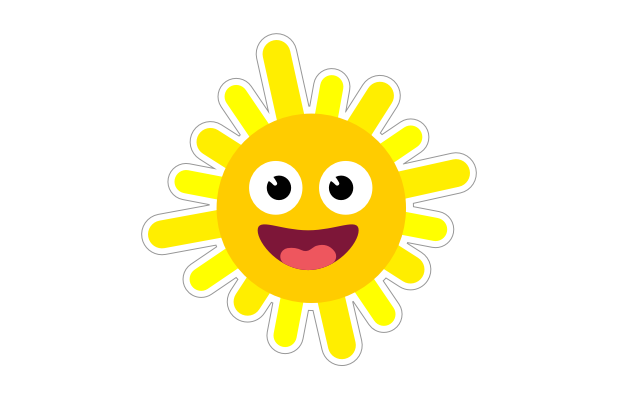
This helps your infant recognize the names of common animals along with their unique sounds. The best office about Brute Jam is it can be done anywhere, even in the machine!
2. Sound Stories
Storytime is a wonderful time to bond with your baby. Just it is likewise a way to enrich your babe's linguistic communication development. To acquire speech skills, your baby also needs to larn nonverbal communication and sounds in response to everyday things. Instead of reading through a book,make reading fun by adding facial expressions, vocalism inflections, sound effects, and animal sounds.
3. Talk Dorsum
Babies communicate by crying, cooing, and squealing to get your attention.When he/she is communicating with you, beginning talking back.If your infant coos, coo back. If baby smiles at you from across the room, smile dorsum while saying 'Hello' and waving.
Babies learn through imitation. Over time your baby will not only smiling, simply say 'How-do-you-do' back to you lot while waving.
4. Name That Color
Everything is made of colour. To aid foster early colour recognition,say the colors of everything you lot meet.
For example: Name the colors of cars passing past while taking a walk to the park; tell your infant what color dress he/she is wearing, toy colors, and more!
5. Karaoke
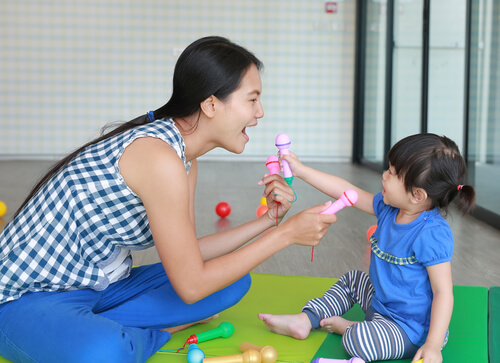
Whether you can keep a tune or non, your infant doesn't care!Singing is a perfect way to provide a language learning opportunity that includes voice inflections, new words, and facial expressions. Then go ahead and make a lightheaded face while singing at the top of your lungs!
half dozen. Monkey See, Monkey Practice
"Monkey see, monkey do" is all about facial expressions. Facial expressions are an important aspect of oral communication development because they convey emotions. Research suggests that nonverbal forms of communication like facial expressions make up threescore to 65% of communication.
To encourage increased emotions through facial expressions,hold your baby in front end of yous and mimic his/her facial expressions. When your baby smiles, smile back. Better withal! Stick out your tongue, brand a silly face, and lookout man to run into if babe repeats your expressions.
7. Mirror, Mirror
Since stomach fourth dimension is an essential part of a baby'due south physical development,have advantage of tummy time by using a mirror. Non merely will baby enjoy his/her reflection, but each time a coo or giggle is made your baby tin can see where the sound is coming from and his/her facial expressions when 'speaking.'
8. Wheel
After a diaper change or someday your baby is on his/her back,take baby's legs in move them in bike motions while singing a giddy song or reciting a nursery rhyme. The bicycling motion will allow baby to focus on your face while you sing or speak to her/him.
9. Face-To-Face
Face-to-face is one of my favorite fun activities for promoting spoken communication development! Lay on the flooring with your little one and face each other. Point to areas of her/his face while naming the parts of the confront. This will help your babe not just acquire paw/eye coordination, but early recognition of parts of the face.
Better withal, take this activity one step further by doing the following case:
- Indicate to baby's olfactory organ and say 'nose'
- Take baby's hand and affect your olfactory organ while saying 'nose'
Having baby bear upon your nose allows her/him to understand that everyone has like body parts with the aforementioned names.
ten. Repeat later Me
This simple game works best when facing your baby.Start making babbling sounds AKA baby talk (especially with vowel sounds) and await for your babe to repeat them back to you. Some common coos and babbling sounds include: Oohh/aww; mamma/dada.
This type of spoken language normally does not develop until four months of historic period. And then don't exist upset if your one-calendar month-old is not catching on, just requite it time. Before long you lot and infant volition be chattering dorsum-and-forth.
11. Say My Proper name
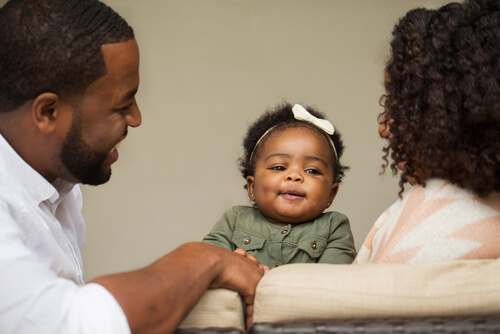
One of the biggest linguistic communication developments a baby will make is learning/recognizing his/her proper name! While it'southward different for every baby, nigh babies volition recognize and respond to their names between 3 to vi months of age.
To aid baby along with this language development, say your babe's name whenever possible. Some fun ways to say your infant's name include:
- Adding his/her name to a silly vocal,
- Asking a question with his/her name,
- Replacing the names of volume characters with your baby'south name.
12. Echo
To develop language babies need to echo or 'echo' words. A keen fashion to include new words and increment language skills is past calculation expressive phrases to everyday situations.
For instance, if your baby drops his/her bottle on the floor say, "Oh no!"
I've plant this activity besides helps develop voice communication by adding sound effects to baby'southward activities.Each fourth dimension your baby jumps while holding him/her, add a sound upshot like "boing, boing." While trying to at-home your crying babe, rock him/her back and forth while proverb, "swoosh, swoosh."
Over fourth dimension, babe will brainstorm to "echo" what he/she hears.
I know information technology seems silly, and that'due south considering it is! Echo is meant to be a fun learning activity for babies, so the sillier you get with sound effects and funny phrases the more than baby absorbs new words, sounds, and phrases.
xiii. This Little Piggie
Next time, your infant is laying on his/her back, grab a foot and outset saying the rhyme "This Niggling Piggie." Since this game doesn't number each of the five toes, the rhyme needs to be modified to aid infant larn numbers.
Instead of saying "This little piggie went to the market" say, "The starting time petty piggie went to the market; the second little piggie stayed home," etc.
Another I've done the rhyme to help with number recognition is past proverb the rhyme the post-obit mode:
- "Ane little piggie went to the market place"
- "Two footling piggies stayed home"
- "Three little piggies had roast beef"
- "Four little piggies had none"
- "And v petty piggies cried wee, wee, wee all the way home"
While this may give the rhyme much more little piggies,it still allows your babe to hear each number and count the number with each toe.
fourteen. Carpool
Carpool is an activeness that's perfect for crawling babies! While infant is crawling, get downwardly and your hands and knees and teach baby how to push a car or truck as she/he is crawling. Your baby doesn't have to go along a constant hand on the car, just a little push in between crawling motions.
To include speech development,add car sound furnishings;tell a funny storyabout the car ride;sing "Wheels on the Passenger vehicle/Car/Truck"; etc.
xv. Roll-A-Ball
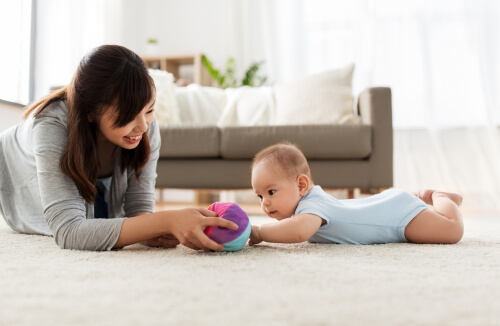
This game if perfect for babies who can sit unsupported and have decent hand/center coordination.Merely take a (medium- to big-sized) brawl and roll the ball directly toward him/her. Incorporate linguistic communication skills by saying phrases like "Here is your ruddy brawl!"
Roll-A-Ball can get more than advanced past helping baby understand simple instructions and responding to those instructions. Effort rolling a ball over to him/her and asking him/her to roll the ball back.
16. Count with Me
You can help your baby with learning numbers past counting out loud to him/her every 24-hour interval. This action doesn't require actress effort on your part, but start talking and counting out loud.
The following are great ways to include number counting each day:
- Count each stair step as you lot carry infant upstairs,
- Count how many bananas y'all bought at the shop,
- Count baby's fingers and toes.
17. Disappear, Reappear
Instead of playing a regular game of peek-a-boo, try playing with your baby's favorite toy or stuffed animal.Hibernate his/her toy from view. Await and few seconds and say "peek-a-boo." You tin can also contain more speaking skills into the game by adding some artistic dialogue!
Examples: "Peek-a-boo! There yous are . . . Mister Deport missed you so much! Thank goodness you found him!"
eighteen. Finger Puppets
Small finger or hand puppets are an amazing way to help develop language skills for your little one! By using finger or paw puppets to tell a story you lot are showing baby the following language and spoken communication skills:
- Different facial expressionsto prove emotions when speaking
- Artistic dialoguebetween two or more than puppets (similar to speaking between two people).
19. Fruits and Veggies
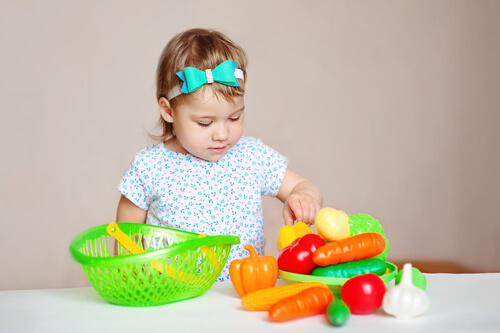
Much of a baby'south speech communication development has to do with repetitive hearing and use of everyday words. Ane mode to help with discussion recognition of common fruits and vegetables is byplaying pretend with plastic fruits and vegetables.
Although infant will need to be supervised with pretend plastic food considering of pocket-sized pieces, he/she will learn how to recognize a assistant, carrot, pear, and more than!
Besides, don't forget to count your fruits and veggies for number recognition!
20. Motion picture This
I of the easiest means to help develop linguistic communication skills in babies is through flashcards. Flashcards with pictures and writinghelp your babe begin to recognize what the picture or action is on the card along with the corresponding word or phrase.
While your infant won't say the words out loud for a while, information technology helps him/her to recognize the picture with the associated word.
21. Build a Tower
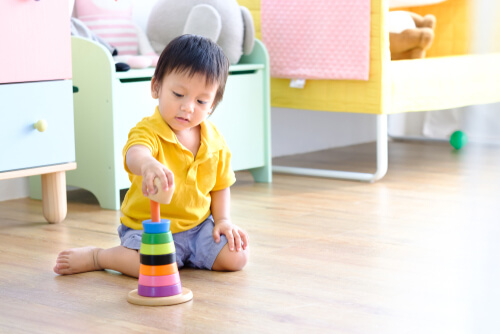
Building a tower with blocks is perfect for developing hand/eye coordination. Merely this activeness can also be used for encouraging language development in babies.
As you spotter or directly help your kid stack blocks,say the colour of the block along with counting the blocks equally the tower is beingness stacked. Many available babe blocks too accept pictures in which you tin draw the film to your baby. For instance: If you lot have blocks with animals pictured on them, name each beast along with the sound the creature makes.
It's a Procedure
Speech development is more than than speaking words. Information technology is a complex system of verbal and nonverbal communication. To express emotions and thoughts you baby will first begin to cry to communicate his or her needs to you.
After advice crying, the heaven is the limit for spoken language development and your baby!
But your baby needs your assist along the way! The best way to develop language skills by year 1 is through imagination and play.
Each of the 21 activities above combines:
- Imaginative play,
- Simple instructions for you and baby to follow,
- Activities involving both exact and nonverbal speech.
And then start playing some of these fun spoken communication and language activities to give your babe a caput start before he or she turns one!
Read more on how to utilise kids activities to attain developmental milestones! If your toddler already reached their wonderful twos, considerusingSpeech Blubs App in combination with offline games for kids to build their vocabulary.
Spoken communication Blubs App Helps Your Child Catch up!
Brand certain to download the Voice communication Blubs app: available in App Shop, Google Play Store, and on our website! Work on simulated and articulation skills, build vocabulary to limited needs, and converse more than! Ready your personalised goals now and start learning.
Speech Blubs is a learning app for everyone: If you want to work on language evolution or your child has a speech filibuster, autism, Down syndrome, hearing loss, tongue necktie, crack palate, or Apraxia – kids find this app very helpful. More than iv+ million parents tried the app – see what they have to say about it.
Y'all go free admission to Parents Academy and educational videos most speech development in the app. You can fifty-fifty talk to our speech therapist if you have concerns! If you are still unsure, watch our free webinar with speech therapist Tori or bring together our Facebook Group for parents.
Go started with Speech Blubs
Cancel anytime, hassle-free!
Source: https://speechblubs.com/blog/baby-activities-language-development/
0 Response to "Activities to Promote Language Development in Two Months Old Baby"
Post a Comment